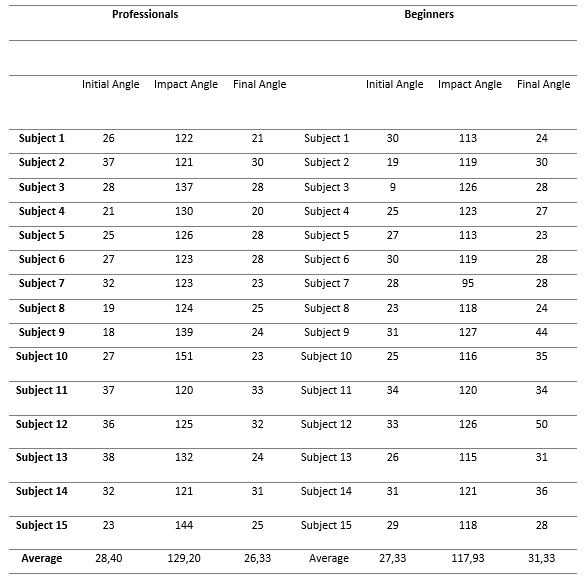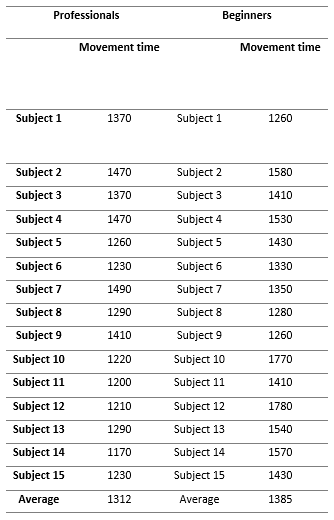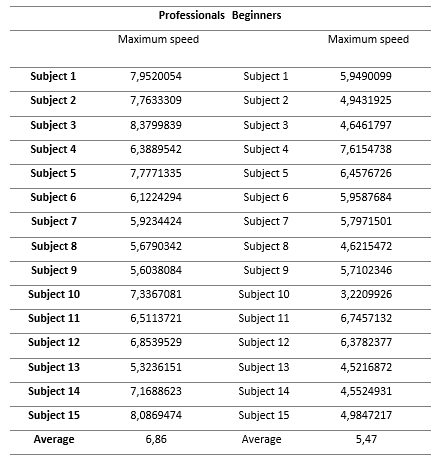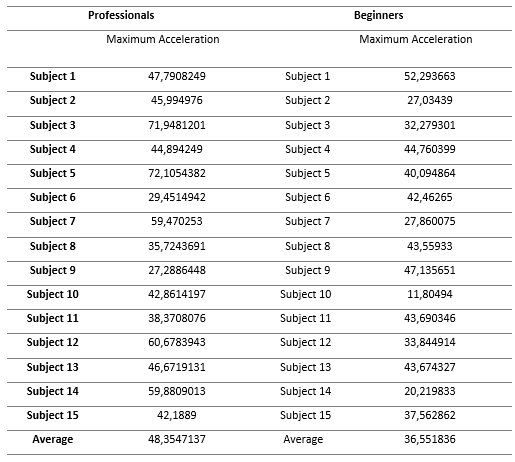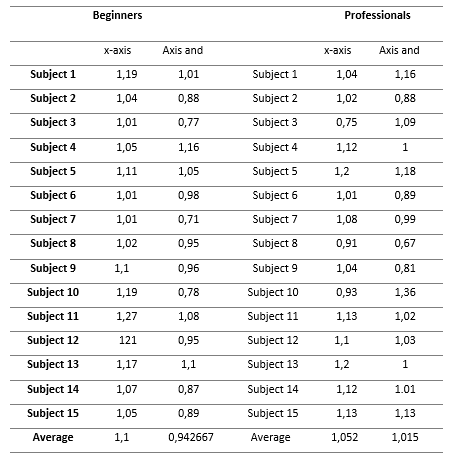My SciELO
Services on Demand
Journal
Article
Indicators
-
 Cited by SciELO
Cited by SciELO
Related links
-
 Similars in
SciELO
Similars in
SciELO
Share
Podium. Revista de Ciencia y Tecnología en la Cultura Física
On-line version ISSN 1996-2452
Rev Podium vol.17 no.1 Pinar del Río Jan.-Apr. 2022 Epub Apr 15, 2022
Original article
Biomechanical differences in the chigo-Chagüi kick with the front leg in female beginner and advanced taekwondo fighters
1Universidad de las Fuerzas Armadas ESPE. Ecuador.
The analysis of sports technique between different performance levels serves to establish methodological comparisons that contribute to the improvement of specialized motor performance, including eminently technical-tactical sports. In this sense, the objective of the research is to analyze the biomechanical differences between professional and amateur taekwondo athletes in the performance of the Chigo-Chagüi kick with front leg. Two independent groups were studied, 15 Beginner Athletes (DPRI in Spanish) and15 Professional or advanced Athletes (DPRO in Spanish); indicators of Speed, Flexion Angle and Center of Gravity were studied and a comparison was established. An initial angle of DPRO=28.4° and DPRI: 27.34° (p=0.309) and an impact angle of DPRI= 117.93º and DPRO=129.2º (p=0.001) and a final angle of DPRI=31.34º and DPRO=26.34º (p=0.057) were determined, with a kick execution time of DPRO=1312ms and DPRI=1462 ms (p=0.009), a maximum velocity of DPRO=6.86 m/s and DPRI=5.47 m/s (p=0.003) and an average acceleration of DPRO=48.35 m/s2 and DPRI=36.55 m/s2 (p=0.029), being the center of gravity for the impact point in Axis X with no significant differences (p=0.506) and in Axis Y with significant differences between independent groups (p=0.029). The differences between advanced and beginner athletes in the chigo-chagüi kick with front leg are usually remarkable in most of the indicators analyzed, being the level of the athlete an indicator that allows describing the technical deficiencies.
Keywords: Biomechanics; Taekwondo; Chigo-chagüi; Speed; Angle; Trajectory
INTRODUCTION
Taekwondo is a combat sport, of Olympic character, (Kazemi, Waalen, Morgan, & White, 2006), it is based on the use of 80 % of kicks and only 20 % of marking in terms of fists within the combats and sports practices, its technique of execution of kicks is the fastest within the martial arts, being otherwise a sport of high reaction speed, (da Silva Santos, Loturco, & Franchini, 2018) for which reason, kicking techniques are highlighted as a priority in the theory and methodology applied to its training.
The chigo-chagüi technique or also called downward kick is one of the most dangerous and high impact techniques, since at the time of its execution the attacker must lift the knee and extend the foot in the direction of the opponent's face, dropping the sole of the foot on the opponent's face. According to its effectiveness in combat, it is a way to get 3 points or achieve a KO (Troya-Mogrovejo, 2013; WTF, 2020).
Biomechanics is a technique that provides an extensive source of data related to the physics of motor movements, widely explored from the mechanical point of view in direct relation to the efficient control of sports performance, being useful for the evaluation and understanding of human locomotion, being able to detect advantages and limitations of motor movement, (McGinnis, 2013; León, Calero, & Chávez, 2016; Granda, Loachamin, & Arla, 2016; Luigi T. Bercades & Willy Pieter, 2007) who lead to perfect essential components such as technique and technical-tactical performance.
The study of the biomechanical differences between beginners and advanced in the Chigo-Chagüi technique is directed to enhance certain magnitudes, including the reaction speed, (Swandana, Sugiharto, & Wahyu, 2021) since there are moments when the need to react quickly in milliseconds is an effective response to an elite or novice opponent to perform a kick in taekwondo, (Ervilha, Fernandes, Souza, & Hamill, 2020), which becomes essential in the actions of the athlete (Martinez & Escobar, 2017). Therefore, the transcendental importance of specialized training to improve speed, agility and quickness in taekwondo at any level, (Akhmad, Nugraha, & Sembiring, 2021) either through traditional models or comprehensive models of sports preparation (Tipán, et al., 2017).
One of the most studied variables in biomechanics applied to sports performance is the center of gravity, which constitutes an advantageous position to keep the body balanced on a firm support base, (WTF, 2020; Loachamin, Mena, Durán, & Maqueira, 2017), where the center of gravity is correctly aligned and distributed on the feet when performing any technical action.
The trajectory of the movement and the angles of the joint are measures that allow the correction of many aspects such as location, a correct technical optimization, posture and the execution and effectiveness of the kick, (Marlene J Adrian & John M Cooper, 1995). This considers physical capabilities such as flexibility in the angles of the joints of the lower limbs, is a priority to perform the Chigo-Chagüi kick, being equally a fundamental direction of the sport under study, (Paramitha, Rosadi, Ramadhan, & Suwanta, 2020) as well as other variables such as maximum speed (Saransig, Lopez, & Aldaz, 2021).
Given the possible existence of differences in the technical executions in taekwondo, according to the levels presented by athletes, the purpose of the research is to determine the biomechanical differences between beginners and advanced athletes in the chigo-chagüi kick with the front leg of taekwondo, hoping that the results obtained will provide professionals with reliable indicators in order to correct and enhance the training of the Chigo-Chagüi technique.
MATERIALS AND METHODS
A population of 30 athletes was studied, from them, 15 were beginner athletes and 15 were professional athletes from the DAIGORO Specialized Training Club, both men and women, in the city of Quito, Republic of Ecuador.
According to their training time, the athletes were classified into the following independent groups:
Beginner Athletes (DPRI): have a very short training time and have no more than one year of training experience. Total: 15 Athletes.
Professional Athletes (DPRO): have more than three years of training in the discipline and range from blue green belt to black belt (1dan), possessing an already perfected technique of the chigo-chagüi kicking technique with front leg.
For data analysis, the Kinovea program version 0.8.27 was used and for data tabulation and correlation, the SPSS V25 program was used, applying the Mann-Whitney U test (p= 0.05) since there was no normal distribution of the data.
The analysis was carried out with the tools provided by the Kinovea program. It was taken into account the following magnitudes:
Speed: it was measured at the exact moment when the Chigo-Chagüi kick movement starts, reaches its maximum point and descends until it reaches the initial position again.
Center of gravity: it was measured at the moment when the athlete reaches the point of maximum extension and height of the kick, after having performed the knee flexion and elevation phase; tools and a human model were selected to match the predetermined points with the athlete's joints.
Flexion angle: to measure it, an angle was inserted taking as vertex the coxofemoral joint and the ankle joint in the initial and final impact position.
To obtain the trajectory, a reference point was placed on the lateral malleolus of the foot when the athlete initiates the movement of the chigo-chagüi technique; the option follow trajectory was selected and the process ends when the athlete returns to his combat position. The graph that will be obtained will be a curvilinear line that allows the analysis of the motor movement.
RESULTS
Table 1 shows the results achieved by the professional athletes in the Chigo-Chagüi kick with front leg, where the angle in initial position (X1) presented an average of 28.4°, the angle of average position (X2) an average of 129.2°, the angle of final position an average of 26.33° (X3), the movement time with an average of 1312ms (milliseconds)(X4), the maximum trajectory velocity with an average of 6.85m/s (X5), the maximum trajectory acceleration with an average of 48.35m/s2 (X6) and the center of gravity (X7) with a mean or average in the X-axis of 1.052° and in the Y-axis of 1.015° (Table 1).
Table 1. - Results of professional athletes in the Chigo-Chagüi kick
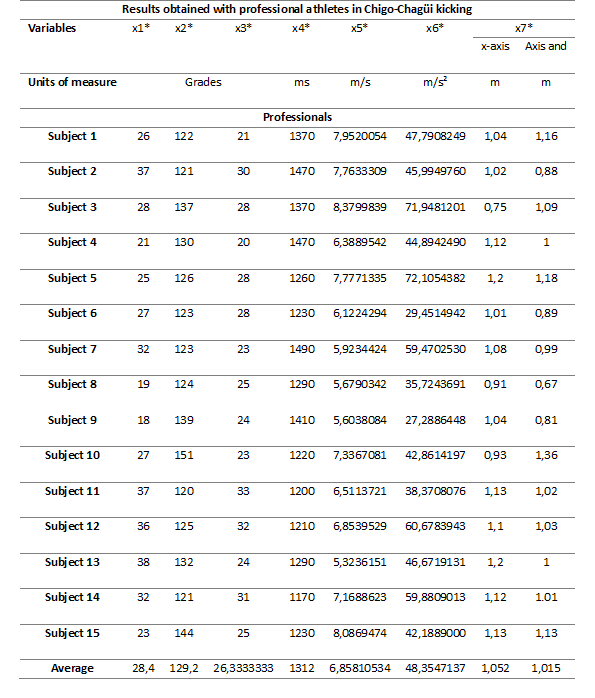
* Legend: X1 =Initial position angle; X2 =Median position angle; X3 =End position angle; X4=Time of movement; X5 =Maximum trajectory velocity; X6 =Maximum trajectory acceleration; X7 =Center of gravity
Table 2 evidences the results achieved by the beginner athletes in the Chigo-Chagüi kick with front leg, where the angle in initial position (X1) presented an average of 27.33°, the angle of average position (X2) an average of 117.93°, the angle of final position an average of 31.33° (X3), the movement time with an average of 1462ms (X4), the maximum trajectory velocity with an average of 5.47m/s (X5), the maximum trajectory acceleration with an average of 36.55m/s2 (X6) and the center of gravity (X7) with an average in the Xaxis of 1.1° and in the Y-axis of °0.9427 (Table 2).
Table 2 Results of the beginner athletes in the Chigo-Chagüi kick
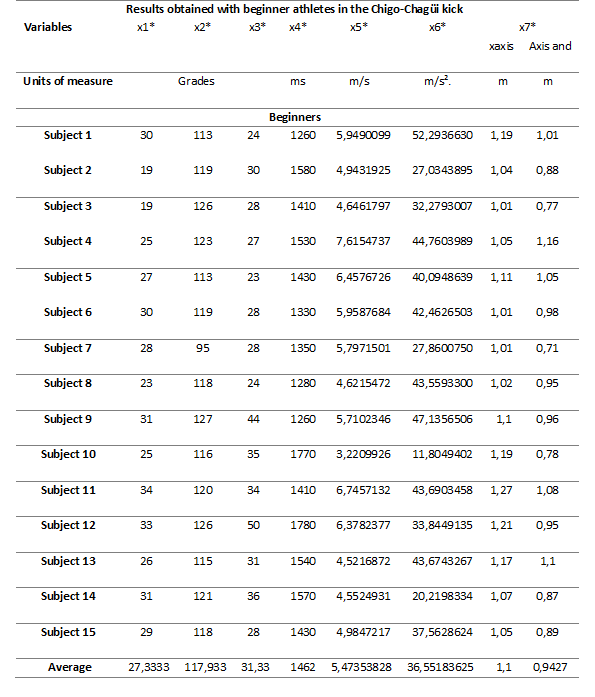
*Legend X1 =Start position angle; X2 =Middle position angle; X3 =End position angle; X4 =Time of movement; X5 = Maximum trajectory velocity; X6 = Maximum trajectory acceleration; X7 = Center of gravity; X8 = Maximum trajectory acceleration; X9 = Maximum trajectory acceleration; X9 = Maximum trajectory acceleration; X9 = Center of gravity
Table 3 shows the angle of impact in the Chigo-Chagüi kick of professional and beginner athletes, where, in the former, the initial angle establishes an average of 28.4°, the angle of impact established an average of 129.2° and the final angle an average of 26.33°. The beginner athletes in the angle of impact in the Chigo-Chagüi kick establish for the initial angle a mean of 27.33°, the angle of impact a mean of 117.92° (showing that the angle of impact has a range of 95°-127°) and the final angle a mean of 31.33° (Table 3).
On the other hand, table 4 shows the results of the professional and beginner athletes in the movement time of the Chigo-Chagüi kick, establishing a mean or average in the professional athletes of 1312 ms, with a maximum value of 1490 ms and a minimum value of 1170 ms. On the other hand, in the beginner athletes a mean or average of 1385 ms was established, with a maximum value of 1780 ms and a minimum value of 1260 ms (Table 4).
Table 5 shows the results of the professional and beginner athletes in the maximum speed of the Chigo-Chagüi kick, establishing for the professionals an average of 6.8 6m/s, with a minimum value of 5.32361507 m/s and a maximum value of 8.3799839 m/s. While for the beginner athletes, a mean of 5.47 m/s was established, with a minimum value of 3.22099257 m/s and a maximum value of 7.61547375 m/s (Table 5).
In the case of professional athletes (Table 6), in the results of the maximum acceleration of the Chigo-Chagüi kick, an average of 48.35 m/s2 was obtained, while in the results of the beginner athletes an average of 36.55 m/s2 was obtained.
Table 7 shows the results of the beginner and professional athletes in the center of gravity as part of the point of impact of the Chigo-Chagüi kick, where the beginners obtain an average in the X-axis of 1.1° and an average in the Y-axis of 0.94° and the professionals obtain an average in the X-axis of 1.052° and in the Y-axis of 1.015°, taking into account that the coordinate system was located in the athlete's support foot.
DISCUSSION
It was determined that professional athletes have an average initial angle of 28.4° and beginner athletes have an average angle of 27.34°, which reflects that there is no greater variation in the angle of the initial position between the two groups. In addition, by means of the comparative calculation from the Mann-Whitney U test, it was determined that there were no significant differences (p=0.039), establishing a lower average range in the beginner athletes (13.87) than in the professional athletes (17.13).
The angle of impact of the beginner athletes averages 117.93º and the angle of the professional athletes is 129.2º, which reflects the existence of a greater variation in the angle of the impact position between both groups, in addition, by means of the comparative calculation from the Mann-Whitney U test, the existence of significant differences was determined (p=0.001), establishing a lower average range in the beginner athletes (10.23) than in the professional athletes (20.77).
In the final angle, it is observed that the beginner athletes have an average of 31, 34º and the average angle of the professional athletes is 26, 34º, determining that there is no greater variation in the angle of the final position between both groups, there is no significant difference (p=0.057), a lower average range is established in the professional athletes (18.53) than in the beginner athletes (12.47).
One of the aspects related to the angles and their description in degrees is the existing relationship with the physical capacity of flexibility, (Tacan, Werz, & Cevallos, 2021) a better joint amplitude could derive in a better muscular flexibility and, therefore, a greater probability of moving the lower limbs in taekwondo derives in an increase of sport performance in terms of kicking precision, as defined in Paramitha, Rosadi, Ramadhan, & Suwanta, (2020).
In the execution time, there was an average of 1312 ms in the professional athletes and an average of 1462 ms in the beginner athletes, which determined that there is a greater variation in kick execution time between both groups, there are significant differences (p=0.009) and a lower average range is established in the professional athletes (11,33) than in the beginner athletes (19,67), indicative that the professional athletes have a shorter execution time and, therefore, a better specific speed capacity.
It was determined that professional athletes have an average maximum speed of 6, 86m/s and beginner athletes have an average maximum speed of 5.47 m/s, which reflects that there is a greater variation in the maximum speed of the kick between both groups, determining significant differences (p=0.003) and the average range is lower in beginner athletes (10,80) than in professionals (20,20), indicative of a better speed capacity of professional athletes, an aspect studied in other works such as (Saransig, López, &Aldaz, 2021).
The average acceleration of the professional or advanced athletes is 48, 35m/s2, and the average acceleration of the beginner athletes was 36.55 m/s2, which reflects the existence of a greater variation in the maximum acceleration of the kick between independent groups, which is significantly different (p=0.029) by establishing a lower average range in the beginner athletes (12.00) than in the professionals (19.00), indicating that the latter mentioned have a greater acceleration by having a better physical preparation.
The comparative calculation of the center of gravity in the coordinate axis (X) for the point of impact during the execution of the Chigo-Chagüi front leg kick between beginner and professional athletes did not determine significant differences (p=0.506), which establishes a lower average range in the professional athletes (14.43) than in the beginners (16.57). In the case of the comparative calculation of the center of gravity in the coordinate axis (Y), the point of impact during the execution of the Chigo-Chagüi kick, with front leg between beginner and professional athletes from the Mann-Whitney U test, determined significant differences (p=0.029), which establishes a lower average range in beginner athletes (12.00) than in professional athletes (19.00).
It is observed that the center of gravity in the X-coordinate axis in beginners is 1.1 and in the Y-coordinate axis is 0, 94 and in professionals, the X-coordinate axis is 1.052 and in the Y-coordinate axis is 1.015, which shows during the ascent phase until reaching the point of impact; the center of gravity tends to shift more towards the supporting foot and greater stability is obtained. On the other hand, during the ascent phase of the striking foot, the center of gravity tends to shift towards where the performing leg moves, which raises the center of gravity to some degree.
Professional athletes have greater experience in the execution of the kick, in addition to being more flexible to perform the Chigo-Chagüi kick with the front leg; therefore, their angle at the point of impact is greater compared to beginners, who have less flexibility, i.e., the blow is more precise and efficient, even managing to overcome the opponent's head, which would be a competitive advantage in combat (Paramitha, Rosadi, Ramadhan, & Suwanta, 2020).
The total execution time of the Chigo-Chagüi technique with the front leg is shorter in the professionals than in the beginners, given that they have automated the movement due to the time they have been training. Similarly, it is determined that the maximum speed in the professionals perfects the technical-tactical action of the kick, which provides an additional competitive advantage to the professionals. In acceleration, differences are also observed in the professionals, their acceleration was greater than that of the beginners, since they have to maximize the acceleration of the thigh, thus transmitting the force to the leg to achieve a stronger impact, since there is a direct relationship between acceleration or linear speed and force (Ojeda-Aravena, Azócar-Gallardo, Hérnandez-Mosqueira, & Herrera-Valenzuela, 2020).
Professional or advanced athletes have much more time of experience, in addition to a better technique, which has been perfected with their greater experience for the correct execution of the different kicks, as opposed to beginner athletes, who have less time of technical learning and, therefore, a lower technical and technical-tactical performance in terms of probabilities.
CONCLUSIONS
The differences between advanced and beginner athletes in the chigo-chagüi kick with front leg are usually remarkable in most of the indicators analyzed, being the level of the athlete an indicator that allows describing the technical deficiencies, as well as serving as a predictor to emphasize the biomechanical elements that affect the sport performance.
ACKNOWLEDGMENTS
Thanks are due to the specialized training club "DAIGORO" for its support in the research process in terms of human resources and sports facilities. To the Afidesa Research Group (Physical Activity, Sport and Health) of the University of the Armed Forces Espe for the advice and implementation of the intervention proposal.
REFERENCIAS BIBLIOGRÁFICAS
Akhmad, I., Nugraha, T., & Sembiring, P. (2021). Speed, Agility, and Quickness (SAQ) training of the circuit system: How does it affect kick speed and agility of junior taekwondo athletes?. Journal Sport Area, 6(2), 175-182. doi:10.25299/sportarea.2021.vol6(2).6433 [ Links ]
da Silva Santos, J. F., Loturco, I., & Franchini, E. (2018). Relationship between frequency speed of kick test performance, optimal load, and anthropometric variables in black-belt taekwondo athletes. Ido Movement for Culture. Journal of Martial Arts Anthropology, 18(1), 39-44. doi:10.14589/ido.18.1.6 [ Links ]
Ervilha, U. F., Fernandes, F. D., Souza, C. C., & Hamill, J. (2020). Reaction time and muscle activation patterns in elite and novice athletes performing a taekwondo kick. Sports biomechanics, 19(5), 665-677. doi:10.1080/14763141.2018.1515244 [ Links ]
Granda, C. A., Loachamin, E. M., & Arla, S. M. (2016). Biomechanical analysis of the Taekwondo Ap-Chagui kick. Lecturas: Educación Física y Deportes, 21(218), 1-7. https://www.efdeportes.com/efd218/biomechanical-analysis-of-the-taekwondo.htm [ Links ]
Kazemi, M., Waalen, J., Morgan, C., & White, A. R. (2006). A profile of Olympic taekwondo competitors. Journal of sports science & medicine, 5(CSSI), 114. https://www.jssm.org/jssm-05-CSSI1-114.xml%3EFulltext [ Links ]
León, S., Calero, S., & Chávez, E. (2016). Morfología funcional y biomecánica deportiva (2E ed.). Quito, Ecuador: Editorial de la Universidad de las Fuerzas Armadas ESPE. [ Links ]
Loachamin, E. M., Mena, F. M., Durán, E. E., & Maqueira, G. d. (2017). Diferencias biomecánicas en la patada ap chagüi entre taekwondocas de cinturón blanco y negro. Revista Cubana de Investigaciones Biomédicas, 36(2), 159-168. http://scielo.sld.cu/scielo.php?pid=S0864-03002017000200013&script=sci_arttext&tlng=en [ Links ]
Luigi T. Bercades, & Willy Pieter. (2007). Un análisis biomecánico de la patada descendente modifi cada de taekwondo. Revista de Artes Marciales Asiáticas, 2(1), 28-39. http://revpubli.unileon.es/ojs/index.php/artesmarciales/article/view/282/239 [ Links ]
Marlene, J. Adrian., & Cooper, John. M., (1995). Biomechanics of Human Movement. WCB. Brown a BenchmarkPub. Iowa. [ Links ]
Martínez, C. A., & Escobar, Y. P. (2017). Sistema de ejercicios para el perfeccionamiento de la velocidad de ejecución simple y compleja en acciones ofensivas del taekwondo en atletas escolares de la EIDE provincia las Tunas. Revista Boletín Redipe, 6(1), 174-192. http://revista.redipe.org/index.php/1/article/view/187 [ Links ]
McGinnis, P. M. (2013). Biomechanics of sport and exercise. Human Kinetics: New York [ Links ]
Ojeda-Aravena, A. P., Azócar-Gallardo, J., Hérnandez-Mosqueira, C., & Herrera-Valenzuela, T. (2020). Relación entre la prueba de agilidad específica en taekwondo (tsat), la fuerza explosiva y la velocidad líneal en 5-m atletas de taekwondo de ambos sexos. Retos, 39, 84-89. doi:10.47197/retos.v0i39.78395 [ Links ]
Paramitha, S. T., Rosadi, T. Y., Ramadhan, M. G., & Suwanta, D. M. (2020). The Influence of Flexibility Training on the Accuracy of the Dollyo Chagi Kick in Taekwondo Martial Arts. In 4th International Conference on Sport Science, Health, and Physical Education (ICSSHPE 2019) Atlantis Press .21, págs. 317-320. https://www.atlantis-press.com/article/125934806.pdf [ Links ]
Saransig, D. D., López, A. P., & Aldaz, E. M. (2021). Diferencias biomecánicas en el taekwondo entre la categoría clasificado y novato realizando la patada mondolyo furyo chagui. Lecturas: Educación Física y Deportes , 26(276), 75-89. doi:10.46642/efd.v26i276.2918 [ Links ]
Swandana, A., Sugiharto, S., & Wahyu, I. S. (2021). Development of Reaction Speed and Endurance Training Tools for Taekwondo Kick Speeds Using Pyongyo. Journal of Physical Education and Sports, 10(1), 8-16. https://journal.unnes.ac.id/sju/index.php/jpes/article/view/44385 [ Links ]
Tacan, E. J., Werz, D. N., & Cevallos, E. C. (2021). Insistencia pasiva dinámica y contracción maximal: influencia en la flexibilidad del split en karate. PODIUM-Revista de Ciencia y Tecnología en la Cultura Física, 16(2), 1-13. http://podium.upr.edu.cu/index.php/podium/article/view/1084 [ Links ]
Tipán, M. G., Quichimbla, H. V., Morales, C., Apolo, E. G., Aldaz, E. M., & Rojas, M. P. (2017). Integrated training vs traditional training in senior taekwondo practitioners. Lecturas: Educación Física y Deportes , 21(224), 1-16. https://efdeportes.com/efd224/integrated-training-in-senior-taekwondo.htm [ Links ]
WTF, W. T. (2020). Competition Rules & Interpretation. Seoul, Korea: World Taekwondo Federation. http://www.worldtaekwondo.org/viewer_pdf/external/pdfjs-2.1.266-dist/web/viewer.html?file=http://www.worldtaekwondo.org/att_file/documents/WT%20Competition%20Rules_Interpretation%20(October%201,%202020).pdf [ Links ]
Received: August 05, 2021; Accepted: November 24, 2021











 text in
text in 


